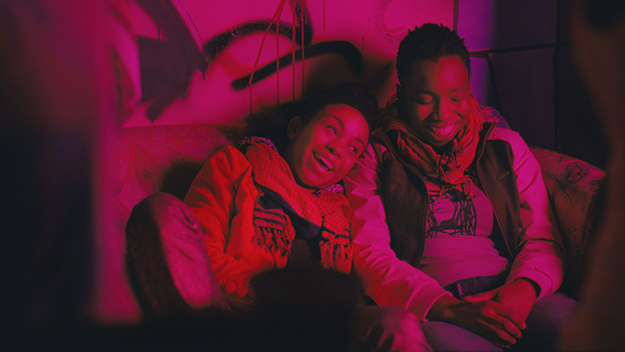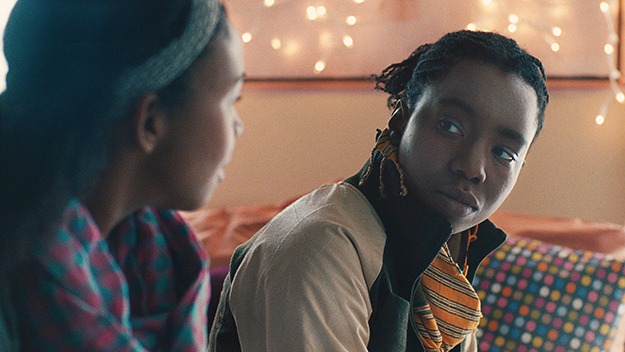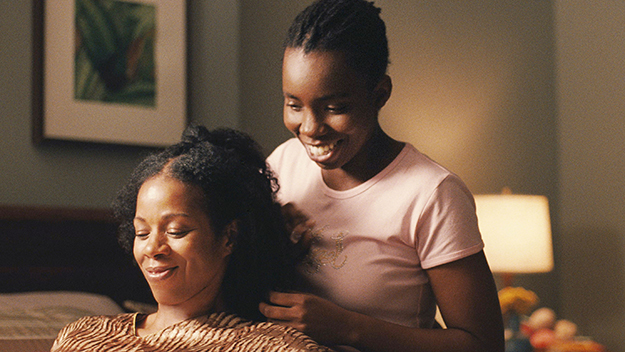Queer and Now and Then: 2011
In this biweekly column, I look back through a century of cinema for traces of queerness, whether in plain sight or under the surface. Read the introductory essay.

All images from Pariah (Dee Rees, 2011)
That mixture of pleasure and shame specific to the queer experience is evident on screen from the opening images of Pariah. Writer-director Dee Rees acknowledges from the very first shots that the act of looking is as essential to sexual identity as just being, and that because of this the object of our affectionate gaze can produce as much anxiety as arousal. While this coming-of-age story proves to be a relatively chaste portrayal of teenage estrangement and confusion, befitting its alienated protagonist, Rees begins the film at a club with a mostly black lesbian clientele, with shadow-enveloped images of a semi-nude stripper sliding athletically up and down a pole to Khia’s undeniable “My Neck, My Back (Lick It).” In a reaction shot, we see high-schooler Alike (Adepero Oduye), who seems to be admiring the view as much as she is made uncomfortable by it: at one moment she wears a wide-open expression, as if she is taking in sunlight for the first time, and the next it could be clouded by disruption.
As the film will go on to show, Alike possesses strength and self-knowledge, but the world being what it is, this doesn’t necessarily make it any easier for her. Rees has called Pariah “semi-autobiographical,” as it heightens and expands upon some of her own difficult experiences coming out to her family, and the film is written, shot, and performed with the sort of constant anxiety—of being found out, of being unloved, of needing constant approbation while also wanting to go your own way—that only a queer filmmaker could truly get at. Though clearer-cut narratives of pride have increasingly become the most “acceptable” form of LGBTQ cinema, Pariah is not necessarily overly concerned with definitive messages of pride, as evidenced right there in its fearful title. Rather it’s about the way we can at least try to get closer to dignity and self-acceptance, even if complete communal approbation remains out of reach.
So much of the discourse around cinemas about people who have been marginalized—whether in terms of gender, race, sexuality, or religion—has often devolved into the specificity vs. universality debate; in other words, should a film try and appeal to the widest possible audience, and can it do so by maintaining an emotional detail and authenticity that can only come from precise cultural specificity? This not only supposes that these concepts must inherently be mutually exclusive—and also prioritizes discussion around that knottiest of artistic terms, authenticity—but also sets up a series of preconceptions about the audiences watching them. Somewhere in between these poles, Pariah got sadly overlooked in 2011. Our essentializing entertainment press, which merrily cloaks its bigotry and biases in overeager marketplace categorization, couldn’t figure out where to “slot” the film and therefore lost interest. One IndieWire headline read “‘Pariah’—Is This ‘Precious’ for 2011?’ and another, mere months later on the same website, insisted “‘Pariah’ Is So Much More Than Just This Year’s ‘Precious’” regardless of the fact that these two films have nothing remotely in common, in subject matter or aesthetics.

An expansion of a short that Rees made as an NYU film student, the Brooklyn-set Pariah (the film was largely shot in Fort Greene) intends to communicate something about lived experience. Rees told Collider upon the film’s release, “As I was writing, I didn’t worry about universality. I knew that the more specific I was, the more true it would ring and the more people from all different backgrounds could relate to it.” According to Rees, the most memorable screening was with a black lesbian group in the San Francisco Bay Area, where she experienced the approval of the community that she was endeavoring to represent. Any film should reflect a certain kind of truth, and the form itself demands that truth be communicable: Pariah’s authenticity is also felt in its ability to connect the female black queer experience to a common cinematic coming-of-age vernacular long reserved for studies of heterosexual whiteness. Alike’s perspective—her looking—gives the film its charge, right from those first shots.
After leaving the club at the beginning of the film, Alike and her friend Laura (Pernell Walker) compare how many girls’ numbers they got; cinematographer Bradford Young captures their faces in tight profile pushed to the left of the frame, street lights out of focus on the left, a composition that communicates both their isolation and that intensely wonderful youthful feeling that in this moment this is all that matters and that the rest of the world can be blocked out. Yet this moment of freedom is short-lived: riding the bus home from the club, Alike—who prefers to go by the more androgynous “Lee” to her friends—swiftly changes out of her baseball hat and striped yellow and white polo shirt (her “boy” clothes) and replaces her earrings. Despite this routine of desperate re-conforming, Alike nevertheless instantly provokes the ire of her mother, Audrey, whose furious chastisement of her daughter’s returning past curfew is clearly indicative of a deeper fury and frustration.
The status of one’s queerness exists in relation to a hetero world that brands anything out of the ordinary as “other,” and therefore Audrey is as essential to Pariah as Alike. As portrayed by Kim Wayans, Audrey is a bundle of nerves, her intense homophobia born out of a desperation to maintain entrenched ideas of domestic happiness. Known almost exclusively for her decades of comedy work, Wayans here internalizes so much anger you can feel the tightness and pinching in her face; it’s a remarkable dramatic extrapolation of and variation on the kinds of profoundly insecure characters Wayans played on In Living Color in the early 1990s. In every scene, Wayans reminds the viewer that intolerance is bred out of profound self-loathing, and that hate is a tragic inability to reckon with the self. Wayans’s sometimes unhinged indignation is effectively played off of Oduye’s nervy calm. The two actors throw one another into relief; both seem like they could break down at any moment, though it’s always obvious that Alike can better handle herself and that she’s headed for the kind of profound self-knowledge that has been denied her overworked, underloved mother.
“I’m tired of this whole tomboy thing she’s been doing,” Audrey tells Alike’s more hesitantly sympathetic, but in-denial father (Charles Parnell) in one of her more euphemistic moments. When Audrey climactically yanks Alike out of the closet, confirming her worst suspicions about her daughter’s sexuality, Rees directs the scene like an earthquake has hit the household. “There’s nothing wrong with me,” Alike insists to her mother, though it seems to fall on deaf ears. Audrey’s narrative isn’t one of gradual acceptance, and the lack of a final reconciliation scene between mother and daughter is one of Pariah’s saddest revelations—and greatest strengths.

Audrey wishes Alike were more like her traditionally feminine younger sister Sharonda, who talks of her excitement about homecoming and the “autumn dance” at the dinner table. The further Audrey tries to push Alike away from her true identity and toward her own preconceived notions of womanhood, the more Alike finds herself; it’s one of the film’s great narrative ironies, and it’s reflective of the essentially self-defeating parental strategy of “tough love,” which leads only to further alienation and, as a result, self-definition. Horrified that Alike is getting too close to the unapologetically butch Laura, Audrey instead forces her to hang out with her co-worker’s daughter, Bina (Aasha Davis). Unbeknownst to Audrey, Alike’s blossoming friendship with the seemingly straitlaced Bina develops into a tentative teen romance, forged through a shared love of black rock music. The attraction between the two young women is sensitively conveyed by Rees, their mutually admiring intimacy giving the film a charge of eroticism and tenderness; when Alike delicately traces Bina’s shoulder tattoo, the tactility is intensely felt, as though she’s never really touched another person before. Unfortunately for Alike, their youthful love proves to be a mere fling, as Bina claims to have just “been playing around,” refusing to define herself as a lesbian.
Audrey’s ostracizing of her daughter, coupled with Bina’s rejection, leads Alike to make the climactic decision to leave home for California, where she has received early college acceptance. In the closest the film comes to reconciliation, her dad tells her she can come home if she wants; her poignant response: “I’m not running, I’m choosing.” Audrey, on the other hand, disallows Alike from having the final word. After she tells her mom she loves her, Audrey, rather than reassure her that she loves her back, responds coldly, “I’ll be praying for you,” and walks away. Having shown Laura’s own devastating rejection by her mother—closing the front door in Laura’s face when she comes home to proudly tell her she passed her GED—Rees would seem to be painting a fairly bleak portrait of the possibilities for parent-child reconciliation in this milieu. Yet as the film’s opening images prove, Pariah is functionally about and of Alike’s perspective rather than those who try to control her image and discard her personhood. Not everyone from Alike’s economic background might have the same opportunities for escape, but in the film’s last shot, as she sits on an outbound bus, the screen is overtaken with a burst of sunlight flare and we might momentarily feel like Alike is the only person in the world who matters. Now that’s cinematic specificity.
Michael Koresky is the Director of Editorial and Creative Strategy at Film Society of Lincoln Center; the co-founder and co-editor of Reverse Shot; a frequent contributor to The Criterion Collection; and the author of the book Terence Davies, published by University of Illinois Press.







